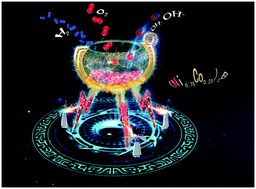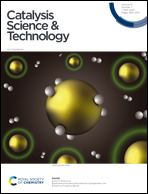Direct observation of chemical origins in crystalline (NixCo1−x)2B oxygen evolution electrocatalysts†
Abstract
The efficiency of hydrogen production through water splitting is limited by the slow kinetics of the oxygen evolution reaction (OER). Although transition bimetal catalysts have advantages for OER, which of the metal plays a dominant role is still not clearly identified. Here, we synthesized a series of crystal (NixCo1−x)2B catalysts via a simple ball-milling method. Among these catalysts, (Ni0.75Co0.25)2B exhibits the best OER activity with a low overpotential of 224 mV at 10 mA cm−2 in a 1 M KOH solution as well as robust stability, which is superior to that of the benchmark IrO2 catalyst. More importantly, the chemical origins of these catalysts have been successfully identified via CV cycling on hydrophobic and hydrophilic electrodes. We found that Co sites served as both the adsorption centers of OH* intermediates and active centers for OER, while Ni sites facilitated the key conversion of Co2+ to Co3+ during OER through CV cycling. The findings are well supported by Raman spectroscopy and X-ray photoelectron spectroscopy (XPS) data. Our results open a reasonable strategy for high-performance OER catalysts.



 Please wait while we load your content...
Please wait while we load your content...